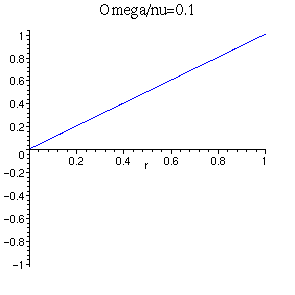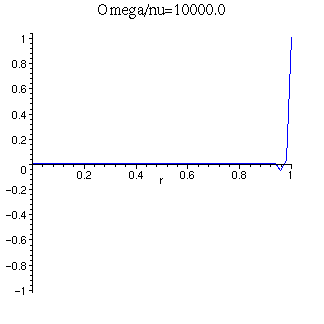![[Maple Math]](images/RotatingFluidAnimation1.gif)
EXAMPLE: VELOCITY FIELD IN A PERIODICALLY OSCILLATING CYLINDER: (MAPLE SESSION)
Here's the azimuthal momentum equation: A Bessel equation
> ode:=r^2*diff(V(r),r$2)+r*diff(V(r),r)-(I*Omega/nu*r^2+1)*V(r);
![[Maple Math]](images/RotatingFluidAnimation1.gif)
Let's find the general solution -- unsurprisingly, the solution is a Bessel function
> soln:=dsolve(ode,V(r));
![]()
Show that BesselY is singular at the origin:
> limit(BesselY(1,x),x=0);
![]()
Assign the solution:
> assign(soln);
Get the real part of the full, time-dependent solution: (Apply BC and set nu=1 and a=1 to non-dimensionalise)
> v(r,t):=subs(nu=1,_C1=1/BesselJ(1,sqrt(-I*Omega)),_C2=0,Re(V(r)*exp(I*Omega*t)));
![[Maple Math]](images/RotatingFluidAnimation4.gif)
> with(plots):
ANIMATE THE AZIMUTHAL VELOCITY PROFILES FOR VARIOUS VALUES OF Omega (OR RATHER Omega a^2/nu = Omega a^2 rho / mu):
Small Omega a^2/nu = Omega a^2 rho/mu: Essentially we have a rigid-body rotation; the fluid viscosity mu is so large (relative to the dynamic effects induced by the rotation) that the fluid behaves like a solid. Think of a slowly oscillating jar of honey -- this is the velocity distribution you would expect, right?
>
animate(subs(Omega=0.1,v(r,t)),r=0..1,t=0..2*Pi/0.1,color=blue,title="Omega a^2/nu=0.1");

Intermediate Omega a^2/nu = Omega a^2 rho/mu: The relative importance of fluid inertia (characterised by Omega x rho) is increasing (relative to viscous effects) and the motion of the fluid in the core is beginning to lag behind the motion of the fluid near the wall.
> animate(subs(Omega=100,v(r,t)),r=0..1,t=0..2*Pi/100.0,color=blue,title="Omega a^2/nu=100.0");

Large Omega a^2/nu = Omega a^2 rho/mu:
Viscous effects are negligible in the core. Viscosity can only transmit the boundary motion into a thin layer near the walls. The fluid in the centre of the cylinder
remains at rest. Think of rotating a water bottle very rapidly about its axis -- this is the velocity field you would expect, right?
> animate(subs(Omega=10000,v(r,t)),r=0..1,t=0..2*Pi/10000.0,color=blue,title="Omega a^2/nu=10000.0");

>
>